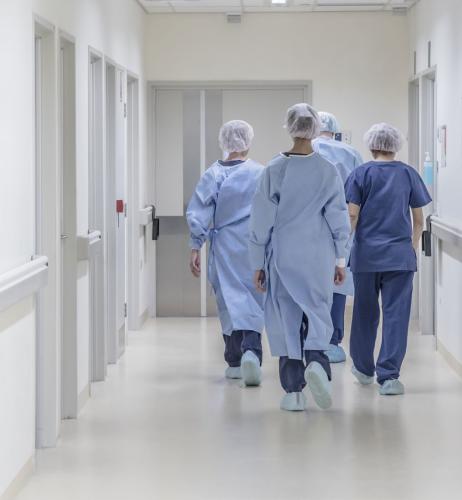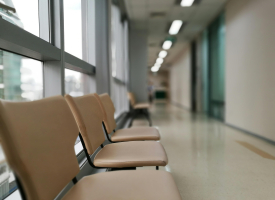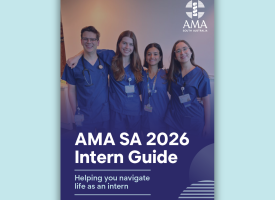AMA's latest Public Hospital Report Card reveals hospitals need our help now
As lockdown lifts across the nation, many remain locked out of timely care.

Australian Medical Association President, Dr Omar Khorshid, said today that the AMA’s Public Hospital Report Card 2021 shows that even during the 2020 lockdowns, hospitals were still overwhelmed – with backsliding or barely improved performance, even with dramatically reduced patient volumes.
“What’s remarkable about this year’s report card is it shows hospitals continued to struggle in 2020 when Australians stayed home, and we weren’t dealing with the highly contagious Delta variant or high COVID-19 hospitalisations,” Dr Khorshid said.
“What we had was a once in a generation event – a dramatic reduction in hospitalisation from accidents, injuries and illness. But what it revealed was that, unless we do something dramatic to help our hospitals, this is as ‘good as it gets’ when it comes to hospital performance for Australians.
“Since the data in this report card was collected, volumes have not only returned to normal, but grown, and we will continue to have COVID-19 on top of it. ‘Good as it gets’ is about to get much worse.”
Key findings of the AMA’s Public Hospital Report Card 2021 highlight that Australians seeking emergency treatment and classed as Urgent – that is needing treatment within 30 minutes or less – only had a one in three chance of being seen on time in the worst-performing jurisdiction.
“So, if you are classed as Urgent, which can include being severely ill, bleeding heavily from cuts, having a major fracture or severe hypertension you have a one in three chance of being seen within 30 minutes in the ACT; and approximately a one in two chance in South Australia and Western Australia.
“At the very best, you’ll have a 3 in 4 chance of being seen in 30 minutes if you live in NSW, after arriving at the hospital. Think about what that means for you or your family.”
Those hoping to be treated and leave the ED in four hours or less are also in for a shock – nationally this was only managed for 69 per cent of Australians.
“So, if you’re in an ED in Victoria, the ACT, Tasmania, South Australia, Northern Territory it’s more likely you’ll still be there after four hours than if you were in WA, NSW or QLD.”
This performance was against a backdrop of the number of patients presenting to EDs dropping 1.4 per cent in 2019-20, a temporary reversal of the trend of 3.2 per cent year-on-year growth over the previous five years.
“The situation for those waiting for essential surgery is just as bad.
“While called ‘elective’ surgery, this really is essential surgery that includes serious conditions like heart valve replacements and cancer investigations. Yet despite putting a hold on non-urgent treatments, and lower ED demand, we treated only 75 per cent within the recommended timeframe for what’s known as Category 2 elective surgery.
“In reality, what this means is that 25 per cent of people will wait longer than 90 days for surgeries, which in this category can include treatment for an unruptured brain aneurism, decompression of a spinal cord and treatment for ovarian cysts or unhealed fractures. And if you’re in Tasmania you’ve got more than a 63 per cent chance you’ll be waiting longer than that – hard to believe for a world class health system.
“It doesn’t matter where you live – you will be waiting longer than ever if you rely on the public hospital system. Your condition will probably worsen. We need to tell the truth here – no single jurisdiction improved its performance on this measure. Not one.
“With this year’s report card covering a lockdown period, it was expected that performance would improve, across the board. The fact that it only improved a little, in a few places, in an inconsistent way should really worry all Australians.
“Because as demand returns, your wait times will increase. So, the chances of you being seen within 90 days for your elective surgery will be less than the current 76 per cent chance you have in Victoria, 88 per cent in Queensland, and 81 per cent in Northern Territory – and these times are all worse than last year to begin with.”
“We need to remind ourselves that behind these figures are people. People who can’t work, who are in pain, who need treatment to get their lives and their health back. Many of us may be leaving lockdown, but those waiting for surgery will continue to be locked out of timely treatment.
One measure of a hospital’s capacity to cope is the number of beds available for those who need them. The ratio of beds available for every 1,000 people over the age of 65 (the most intensive users of public hospital beds) has been on a downward trend for 27 years, and the latest available data (for the pre-pandemic year 2018-19) shows it did not improve.
“Our hospital staff have worked tirelessly to tackle COVID-19 head on. They have delivered care in the most trying of circumstances. But they do not have what they need to continue to care for Australians with non-COVID-19 conditions in a timely manner, and continue to tackle COVID-19 as well.
“But if we look closely at the data there are signs that hospitals, if given the capacity they need, can improve their performance. Of those urgent patients who did arrive at the ED, more were seen within 30 minutes than last year.
“Fewer admissions during the lockdown led to more free beds for those waiting for admission from the ED, therefore freeing up the ED to treat those still waiting outside. That tells us that performance will be improved if we give hospitals the beds, the staff and the resources to do it.
“Our hospitals have served us well, time and time again. It’s time we returned the favour and developed a national partnership to give our hospitals what they need to do their job. They deserve better.”
The AMA Public Hospital Report Card 2021 can be viewed here.



